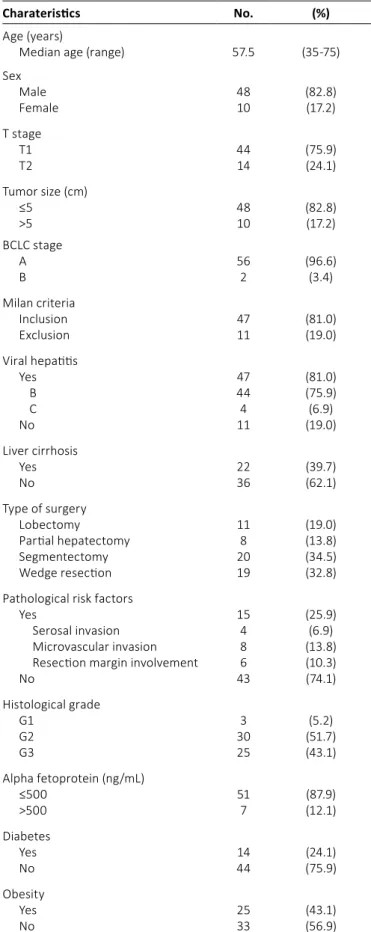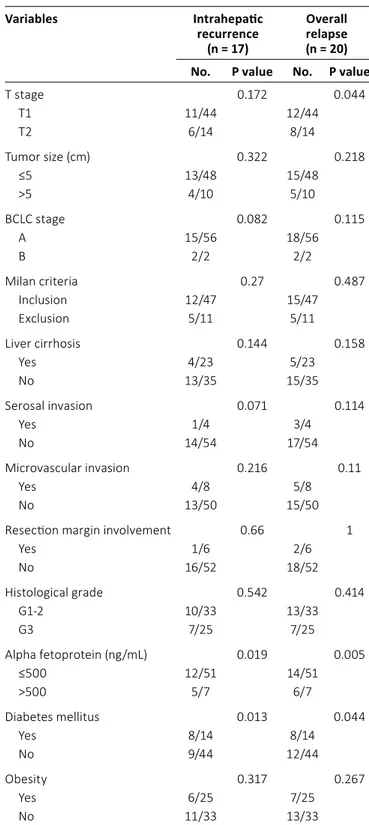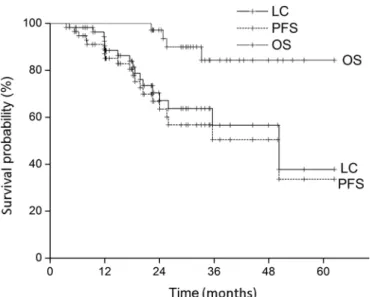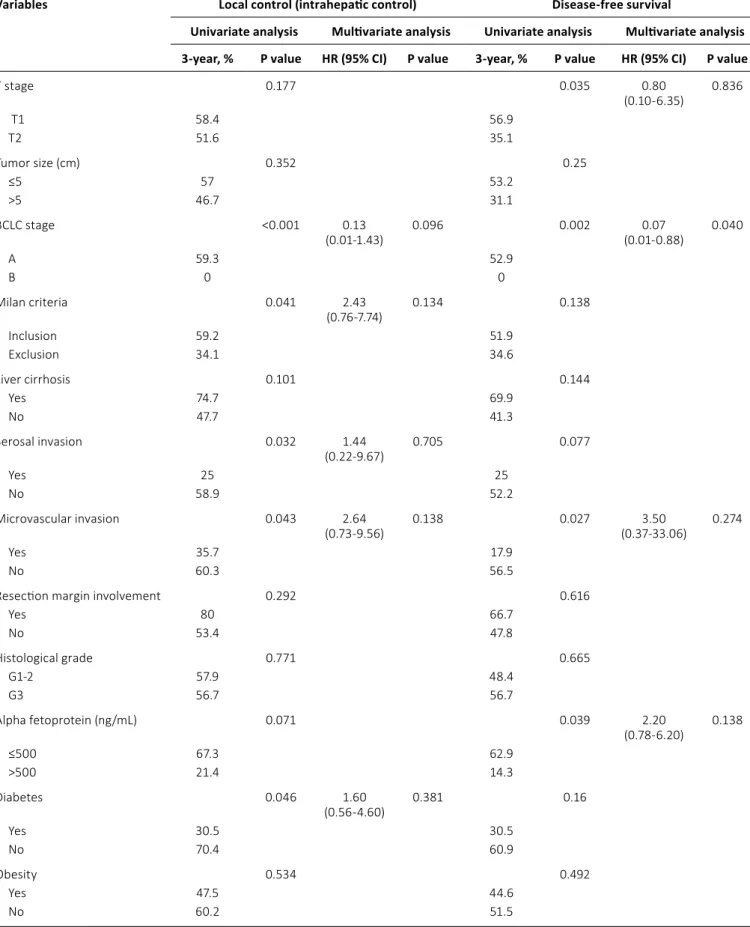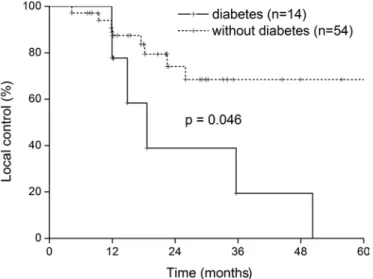TJISSN 0300-8916 ORIGINAL RESEARCH ARTICLE
weight gain and cancer occurrence. In addition, Tsugane et al (7) reported that liver cancers are associated with insulin resistance. In particular, diabetes mellitus is known to be a risk factor for hepatocellular carcinoma (HCC) (4) and to af- fect its prognosis (8, 9). A recent meta-analysis by Wang et al (9) showed that diabetes is associated with poor disease-free survival (DFS) (hazard ratio [HR] = 1.46, 95% confidence inter- val [CI] = 1.29-1.66) and overall survival (OS) (HR = 1.57, 95%
CI = 1.21-2.05) in HCC patients. Komura et al (10) reported that diabetes is related to an increased risk of relapse and decreased OS in patients with hepatitis virus C-related HCC after curative resection. Even though the study by Komura et al did not show any prognostic effect of diabetes in patients with hepatitis virus B-related HCC, these results seem to be caused by the fact that only a small number of hepatitis virus B-related HCC patients (n = 25) were included in the study (10). Therefore, further evaluation of the effect of diabetes on patients with hepatitis virus B-related HCC is warranted.
Additionally, elevated alpha fetoprotein (AFP) level and Child-Pugh class for patients with liver cirrhosis are well- known clinical prognostic factors for HCC. For surgically treated patients, positive resection margins, tumor size >5 cm, and DOI: 10.5301/tj.5000594
Diabetes mellitus increases the risk of intrahepatic recurrence of hepatocellular carcinoma after
surgical resection
Yunseon Choi1, YoungKil Choi2, Chang Soo Choi2, Yun-Han Lee3
1 Department of Radiation Oncology, Inje University School of Medicine, Busan Paik Hospital, Busan - Korea
2 Department of General Surgery, Inje University School of Medicine, Busan Paik Hospital, Busan - Korea
3 Department of Molecular Medicine, College of Medicine, Keimyung University, Daegu - Korea
Introduction
The association between metabolism and cancer has been recognized recently, and is considered a new field of study (1, 2). Cancer incidence and progression are related to the body’s metabolic status (1, 3). The metabolic syndrome (including obesity, diabetes mellitus, hyperlipidemia, and hy- pertension) is known to be closely associated with cancer in- cidence and mortality (4, 5). Keum et al (6) recently reported the results of a meta-analysis on the association between
AbSTRACT
Aims and background: The relationship between cancer and metabolism has recently been receiving attention.
We investigated the prognostic influence of type 2 diabetes mellitus in patients with hepatocellular carcinoma (HCC) treated with curative resection.
Methods and study design: The records of 58 patients who underwent curative resection for HCC pT1-2N0M0 between 2010 and 2014 were reviewed retrospectively. Fourteen patients (24.1%) had diabetes mellitus at diag- nosis. Local control (LC) was defined as time to recurrence in the liver.
Results: The median follow-up was 23.3 months. Relapses occurred in 20 patients (34.5%) during the follow-up period; 17 of them developed intrahepatic recurrence, which was associated with diabetes mellitus (p = 0.013) and alpha fetoprotein (AFP) levels >500 ng/mL (p = 0.019). Overall relapses (n = 20) were related to T stage (p = 0.044), AFP level (p = 0.005), and diabetes (p = 0.044). The 3-year local control (intrahepatic control), disease- free survival, and overall survival rates were 56.7%, 50.5%, and 84.3%, respectively. LC was affected by diabetes mellitus (p = 0.046), Barcelona Clinic Liver Cancer staging (p<0.001), Milan criteria for transplantation (p = 0.041), serosal invasion (p = 0.032), and microvascular invasion (p = 0.043). Diabetes was also associated with reduced LC in the subgroup with hepatitis B-related HCC (n = 44, p = 0.028).
Conclusions: Diabetes mellitus is correlated with intrahepatic HCC recurrence after surgery. Greater attention should be paid to managing patients with HCC and diabetes mellitus.
Keywords: Diabetes mellitus, Hepatocellular carcinoma, Hepatitis B
Accepted: December 4, 2016 Published online: January 7, 2017 Corresponding author:
Yunseon Choi, MD, PhD
Department of Radiation Oncology Busan Paik Hospital
Inje University School of Medicine Bokjiro 75, Busanjin-gu
47392 Busan, Republic of Korea rtyoon@gmail.com
vascular invasion (11, 12) are generally considered poor prog- nostic factors.
Metformin (biguanide), which is used to manage diabe- tes, has been shown to have an antineoplastic effect (13).
Both the adenosine monophosphate kinase and phosphati- dylinositol-3 kinase pathways are believed to be involved in the anticancer effect of metformin (14, 15). The use of met- formin is able to improve cancer treatment outcomes in HCC patients with diabetes (16) and should be evaluated further.
HCC is the third most lethal cancer worldwide (17). In particular, East Asia is an endemic area for hepatitis B. Ex- cept surgery, there are no other effective curative treatment options for HCC (18). For these reasons, HCC is one of the most common malignancies in Korea, and the second most common cause of cancer-related deaths in Korean men (19).
Further clinical investigation is required to find more effective treatment strategies for HCC.
The purpose of this study was to determine the associa- tion between HCC recurrence and metabolic syndrome, and in particular the effect of diabetes. In addition, we evaluated the clinical and pathological prognostic factors related to treatment outcomes in patients with curatively resected HCC.
Materials and methods
We evaluated the medical records of 58 patients with HCC who underwent curative resection between January 2010 and September 2014 at the Inje University Busan Paik Hospital. Every patient received surgical resection and had a pathologically confirmed diagnosis of HCC. None of the patients enrolled in this study had extrahepatic metastases (regional lymph nodal or distant metastases) or a prior medi- cal history of local treatment (surgical resection, radiother- apy, or transarterial chemoembolization). The patients who failed follow-up in the first 3 months after surgery were ex- cluded from the evaluation. This study was approved by the Institutional Review Board of Busan Paik Hospital.
The patient characteristics are summarized in Table I.
The median age was 57.5 years (range: 35-75 years). Forty- eight patients (82.8%) were men. Fifty-one patients (87.9%) had single tumors at diagnosis, whereas 7 (12.1%) had mul- tiple tumors. Patients were classified in accordance with the seventh edition of the American Joint Committee on Cancer Staging Manual. The numbers of patients with stage T1 and T2 disease were 44 (75.9%) and 14 (24.1%), respectively. In addition, most patients had Barcelona Clinic Liver Cancer (BCLC) (20) stage A, and only 2 patients had BCLC stage B. The types of surgery performed were the following: 11 (19.0%) lobectomies, 8 (13.8%) partial hepatectomies, 20 (34.5%) segmentectomies (including 4 lateral segmentectomies), and 19 (32.8%) wedge resections. Two surgeons performed all of the resections in this study. There were 11 patients outside the Milan Criteria for liver transplantation (21).
Forty-seven patients (81.0%) had a medical history of hep- atitis infection. Among them, 44 patients had viral hepatitis B and 4 had viral hepatitis C (1 had both B and C viral hepatitis).
In addition, 22 patients (39.7%) had clinically significant liver cirrhosis.
Pathologically, the high-risk factors for progression in- cluded in this study were serosal invasion (n = 4), vascular
TAbLE I - Patient characteristics (n = 58)
Charateristics No. (%)
Age (years)
Median age (range) 57.5 (35-75)
Sex
Male 48 (82.8)
Female 10 (17.2)
T stage
T1 44 (75.9)
T2 14 (24.1)
Tumor size (cm)
≤5 48 (82.8)
>5 10 (17.2)
BCLC stage
A 56 (96.6)
B 2 (3.4)
Milan criteria
Inclusion 47 (81.0)
Exclusion 11 (19.0)
Viral hepatitis
Yes 47 (81.0)
B 44 (75.9)
C 4 (6.9)
No 11 (19.0)
Liver cirrhosis
Yes 22 (39.7)
No 36 (62.1)
Type of surgery
Lobectomy 11 (19.0)
Partial hepatectomy 8 (13.8)
Segmentectomy 20 (34.5)
Wedge resection 19 (32.8)
Pathological risk factors
Yes 15 (25.9)
Serosal invasion 4 (6.9)
Microvascular invasion 8 (13.8)
Resection margin involvement 6 (10.3)
No 43 (74.1)
Histological grade
G1 3 (5.2)
G2 30 (51.7)
G3 25 (43.1)
Alpha fetoprotein (ng/mL)
≤500 51 (87.9)
>500 7 (12.1)
Diabetes
Yes 14 (24.1)
No 44 (75.9)
Obesity
Yes 25 (43.1)
No 33 (56.9)
BCLC = Barcelona Clinic Liver Cancer.
invasion (n = 8), and positive resection margins (n = 6). Ac- cording to the pathological reports, 10 patients (17.2%) had tumors larger than 5 cm; in cases of multifocal tumors, the diameter of the largest tumor was used as the tumor size.
The degree of cellular differentiation (histological grade) was evaluated; 25 patients (43.1%) had grade 3 (undiffer- entiated) malignancies. The AFP level was >500 ng/mL in 7 patients (12.1%).
Fourteen patients (24.1%) with type 2 diabetes mellitus (diagnostic criteria: fasting plasma glucose level ≥126 mg/dL, hemoglobin A1c level >6.5%, or random glucose level >200 ng/
dL with symptoms) were included in the evaluation. In addition, 25 patients (43.1%) with obesity (body mass index [BMI]
>25 kg/m2) were included in this study.
The treatment response was assessed by using follow- up computed tomography and magnetic resonance imag- ing. Intrahepatic failure was defined as recurrence in the liver, including both marginal recurrence and intrahepatic metastases; regional lymph nodal metastases were defined as regional lymph nodal recurrence (hilar, hepatoduodenal ligament, inferior phrenic, and caval lymph nodes). Distant metastasis was defined as metastasis to distant organs. Lo- cal control (LC), defined as time to recurrence in the liver, was selected as the primary endpoint of this study. The LC rate was calculated from the time of surgery. DFS was de- fined from the date of surgery to overall relapse (including both intrahepatic recurrence and extrahepatic recurrence), death, or last follow-up. OS was measured from the date of surgical resection to death or last follow-up. DFS was assessed as the secondary endpoint to estimate the treat- ment efficacy.
SPSS version 20.0 (IBM) was used for statistical evalua- tion. Fisher’s exact test was used to evaluate the prognostic factors for treatment outcomes. For LC and survival analyses, the Kaplan-Meier method and the log-rank test were used for univariate analysis. The Cox proportional hazards model was used for multivariate analysis. Statistical significance was defined as p<0.05. In addition, p<0.10 was considered to indi- cate marginal significance.
Results
Patterns of failure
The median follow-up period was 23.3 months (range:
5.3-62.4 months). During the follow-up period, 20 patients (34.5%) developed recurrences: 17 (29.3%) developed in- trahepatic (local) recurrence (5 cases of marginal failure and 12 cases of intrahepatic metastases), 1 (1.7%) developed re- gional lymph node failure, and 8 (13.8%) experienced distant metastases. The most frequent distant metastatic site was the lung, in 4 patients. Most patients (13/17, 76.5%) who ex- perienced intrahepatic recurrence underwent transarterial chemoembolization as salvage treatment. During follow-up, 4 patients (6.9%) died of recurrence. There were no deaths related to surgical complications.
Table II summarizes the clinical factors related to treat- ment outcome. Intrahepatic recurrence was associated with diabetes (p = 0.013) and AFP level >500 ng/mL (p = 0.019).
Serosal invasion (p = 0.071) and BCLC stage B (p = 0.082) also
TAbLE II - Clinical factors related to treatment failure
Variables Intrahepatic
recurrence (n = 17)
Overall relapse (n = 20) No. P value No. P value
T stage 0.172 0.044
T1 11/44 12/44
T2 6/14 8/14
Tumor size (cm) 0.322 0.218
≤5 13/48 15/48
>5 4/10 5/10
BCLC stage 0.082 0.115
A 15/56 18/56
B 2/2 2/2
Milan criteria 0.27 0.487
Inclusion 12/47 15/47
Exclusion 5/11 5/11
Liver cirrhosis 0.144 0.158
Yes 4/23 5/23
No 13/35 15/35
Serosal invasion 0.071 0.114
Yes 1/4 3/4
No 14/54 17/54
Microvascular invasion 0.216 0.11
Yes 4/8 5/8
No 13/50 15/50
Resection margin involvement 0.66 1
Yes 1/6 2/6
No 16/52 18/52
Histological grade 0.542 0.414
G1-2 10/33 13/33
G3 7/25 7/25
Alpha fetoprotein (ng/mL) 0.019 0.005
≤500 12/51 14/51
>500 5/7 6/7
Diabetes mellitus 0.013 0.044
Yes 8/14 8/14
No 9/44 12/44
Obesity 0.317 0.267
Yes 6/25 7/25
No 11/33 13/33
BCLC = Barcelona Clinic Liver Cancer.
showed a trend towards higher intrahepatic recurrence rates.
Overall relapse was related to T stage (p = 0.044), AFP level
>500 ng/mL (p = 0.005), and diabetes (p = 0.044). However, obesity was not associated with intrahepatic recurrence (p = 0.317) or overall relapse (p = 0.267).
Diabetes (n = 9) was also significantly correlated with in- trahepatic recurrence in the subgroup analysis of patients with hepatitis B-related HCC (n = 44, p = 0.019 by Fisher’s exact test). Overall relapse tended to be affected by diabetes in patients with hepatitis B-related HCC (p = 0.068).
Local control, disease-free survival, and overall survival Figure 1 shows the LC, DFS, and OS rates. The actuarial 1-year, 2-year, and 3-year LC rates were 90.4%, 67.1%, and 56.7%, respectively. The actuarial 1-year, 2-year, and 3-year DFS rates were 87.1%, 66.8% and 50.5%, respectively. The 1-year, 2-year, and 3-year OS rates were estimated as 100%, 97.1%, and 84.3%, respectively. Intrahepatic recurrence sig- nificantly reduced OS (p = 0.008).
Prognostic factors
Table III summarizes the analysis of prognostic factors for LC. BCLC staging (A vs. B, p<0.001), Milan criteria for transplan- tation (p = 0.041), serosal invasion (p = 0.032), and microvas- cular invasion (p = 0.043) were prognostic factors predictive of a poor outcome. Diabetes also significantly reduced the LC rate (p = 0.046; Fig. 2). However, the prognostic significance of diabetes in LC did not extend to DFS (p = 0.160) or OS (p = 0.264). Prognostic factors for DFS were AFP level >500 ng/mL (p = 0.039), microvascular invasion (p = 0.027), BCLC staging (p = 0.040), and T stage (T1 vs. T2, p = 0.035). In the subgroup analysis for patients with hepatitis B-related HCC (n = 44), we found that diabetes (n = 9) also significantly reduced LC (p = 0.028; Fig. 3). There were no independent prognostic factors for LC in this study (Tab. III). The relative risk of diabetes for local relapse was 1.60 (95% CI = 0.56-4.60). BCLC staging was an independent prognostic factor for DFS (p = 0.040, Tab. III).
Statistically significant changes of LC as reflected by T stag- ing could not be observed in further evaluation. In the sub- group analysis for patients with stage T1 disease (n = 44), we
could not find any significant prognostic effect of diabetes on LC (p = 0.134). There was also no significant effect of diabetes on LC (p = 0.265) in patients with stage T2 disease (n = 14).
Subgroup analysis in patients with diabetes:
anticancer effect of metformin
Among the 14 patients who had diabetes, 5 patients used metformin for the treatment of diabetes. The use of met- formin had no significant effect on intrahepatic recurrence (p = 0.580) or overall relapse (p = 0.357).
Discussion
The results of this study suggested that diabetes may in- crease the risk of intrahepatic relapse in early-stage postoper- ative HCC patients, and that diabetes may have a prognostic impact on HCC in areas endemic for hepatitis B. Active sur- veillance of HCC patients with diabetes and early detection of local relapse may improve LC by adequate timely manage- ment of these patients.
There are several possible mechanisms for the negative impact of diabetes on HCC progression. Diabetes-related vas- cular damage in the liver and release of vascular endothelial growth factor (22) may contribute to increased intrahepatic relapse. Increased insulin-like growth factor І or II levels (22), which are related to insulin insufficiency, may affect progno- sis by stimulating cancer cell growth. Immune dysfunction caused by hyperglycemia can also increase the risk of HCC proliferation (23).
Diabetes is correlated with HCC incidence and recurrence.
Davila et al (24) showed that the incidence of HCC was more than double (HR = 2.87) in patients with diabetes compared with nondiabetic individuals in a large cohort study conducted in the US. According to a study by Koh et al (25), Singapore Chinese with diabetes had an increased incidence of HCC (HR = 2.14) compared with nondiabetics. Additionally, Lai et al (26) reported that the incidence of HCC was twice as high in patients with diabetes (HR = 1.73) compared with nondiabet- ics in Taiwan. Our data are consistent with those presented in these studies. Diabetes was predictive of worse outcomes in patients with HCC after surgical resection in our study.
Good blood glucose control may reduce the rate of HCC progression. Not only diabetes mellitus but also impaired glucose tolerance, which is a prediabetic status of hyper- glycemia, can affect the local recurrence of HCC. Lifestyle modifications (changing diet, exercise, and weight loss) for patients with insulin resistance (7) may be effective in reduc- ing the risk of HCC progression. Further evaluation of glucose levels and the related serological markers could clarify the relationship between glucose metabolism and HCC.
Recently, metformin, an antidiabetic drug regulating cel- lular metabolism, has been widely used for cancer treatment (27). Although this study did not show any anticancer effect of metformin, most likely because of its small sample size, further comparative studies of cancer patients treated with or without metformin are warranted.
The role of obesity in HCC recurrence is still controversial (28). Park et al (29) argued that BMI >25 kg/m2 was not asso- ciated with increased mortality in Korean HCC patients, unlike Fig. 1 - Local control (intrahepatic control) (LC), progression-free
survival (PFS), and overall survival (OS).
TAbLE III - Clinical factors affecting local control (intrahepatic control) and disease-free survival
Variables Local control (intrahepatic control) Disease-free survival
Univariate analysis Multivariate analysis Univariate analysis Multivariate analysis 3-year, % P value HR (95% CI) P value 3-year, % P value HR (95% CI) P value
T stage 0.177 0.035 0.80
(0.10-6.35) 0.836
T1 58.4 56.9
T2 51.6 35.1
Tumor size (cm) 0.352 0.25
≤5 57 53.2
>5 46.7 31.1
BCLC stage <0.001 0.13
(0.01-1.43) 0.096 0.002 0.07
(0.01-0.88) 0.040
A 59.3 52.9
B 0 0
Milan criteria 0.041 2.43
(0.76-7.74) 0.134 0.138
Inclusion 59.2 51.9
Exclusion 34.1 34.6
Liver cirrhosis 0.101 0.144
Yes 74.7 69.9
No 47.7 41.3
Serosal invasion 0.032 1.44
(0.22-9.67) 0.705 0.077
Yes 25 25
No 58.9 52.2
Microvascular invasion 0.043 2.64
(0.73-9.56) 0.138 0.027 3.50
(0.37-33.06) 0.274
Yes 35.7 17.9
No 60.3 56.5
Resection margin involvement 0.292 0.616
Yes 80 66.7
No 53.4 47.8
Histological grade 0.771 0.665
G1-2 57.9 48.4
G3 56.7 56.7
Alpha fetoprotein (ng/mL) 0.071 0.039 2.20
(0.78-6.20) 0.138
≤500 67.3 62.9
>500 21.4 14.3
Diabetes 0.046 1.60
(0.56-4.60) 0.381 0.16
Yes 30.5 30.5
No 70.4 60.9
Obesity 0.534 0.492
Yes 47.5 44.6
No 60.2 51.5
BCLC = Barcelona Clinic Liver Cancer; CI = confidence interval; HR = hazard ratio.
a previous study by Calle et al on cancer patients in the US (30), which showed that obesity (BMI >40 kg/m2) was associ- ated with increased cancer death rates for HCC. Our study results also failed to identify obesity (BMI >25 kg/m2) as a risk factor for recurrence in resected HCC. However, obesity is one of the risk factors for type 2 diabetes. In addition, nutri- tion status is related to an increased risk of diabetes and HCC (31). Therefore, more studies should be performed on this topic in the near future.
This study has some limitations. First of all, it was retro- spective, and because of the retrospective study design, se- lection bias may have influenced the outcome. Furthermore, the follow-up period was relatively short and the sample size relatively small. This study is on the hypothesis-generating level and the results should be interpreted with caution. A multicenter trial would be helpful, allowing the inclusion of
a sufficient number of patients. Nevertheless, we did identify prognostic significance of diabetes in HCC.
In conclusion, diabetes mellitus is related to intrahepatic recurrence of HCC after curative resection. Diabetes is also related to intrahepatic recurrence of hepatitis B-related HCC.
Therefore, HCC patients with diabetes mellitus should be monitored more carefully. Further large-scale, prospective studies are needed to provide more information about the association of diabetes with HCC.
Abbreviations
AFP alpha-fetoprotein
BCLC Barcelona Clinic Liver Cancer BMI body mass index
CI confidence interval DFS disease-free survival HCC hepatocellular carcinoma HR hazard ratio
LC local control OS overall survival Disclosures
Financial support: None.
Conflict of interest: The authors have no conflict of interest to disclose.
References
1. Seyfried TN, Flores RE, Poff AM, D’Agostino DP. Cancer as a metabolic disease: implications for novel therapeutics. Carci- nogenesis. 2014;35(3):515-527.
2. Seyfried TN, Shelton LM. Cancer as a metabolic disease. Nutr Metab (Lond). 2010;7(1):7.
3. Saxena NK, Sharma D, Ding X, et al. Concomitant activation of the JAK/STAT, PI3K/AKT, and ERK signaling is involved in leptin- mediated promotion of invasion and migration of hepatocel- lular carcinoma cells. Cancer Res. 2007;67(6):2497-2507.
4. Fu SC, Huang YW, Wang TC, Hu JT, Chen DS, Yang SS. Increased risk of hepatocellular carcinoma in chronic hepatitis B patients with new onset diabetes: a nationwide cohort study. Aliment Pharmacol Ther. 2015;41(11):1200-1209.
5. Siegel AB, Zhu AX. Metabolic syndrome and hepatocellular car- cinoma: two growing epidemics with a potential link. Cancer.
2009;115(24):5651-5661.
6. Keum N, Greenwood DC, Lee DH, et al. Adult weight gain and adiposity-related cancers: a dose-response meta-analysis of prospective observational studies. J Natl Cancer Inst. 2015;
107(2):djv088.
7. Tsugane S, Inoue M. Insulin resistance and cancer: epidemio- logical evidence. Cancer Sci. 2010;101(5):1073-1079.
8. Wang WM, Xu Y, Yang XR, Wang YH, Sun HX, Fan J. Prognostic role of diabetes mellitus in hepatocellular carcinoma patients after curative treatments: a meta-analysis. Hepatobiliary Pan- creat Dis Int. 2011;10(4):346-355.
9. Wang YY, Huang S, Zhong JH, et al. Impact of diabetes mellitus on the prognosis of patients with hepatocellular carcinoma af- ter curative hepatectomy. PLoS ONE. 2014;9(12):e113858.
10. Komura T, Mizukoshi E, Kita Y, et al. Impact of diabetes on recurrence of hepatocellular carcinoma after surgical treat- ment in patients with viral hepatitis. Am J Gastroenterol. 2007;
102(9):1939-1946.
Fig. 2 - Impact of diabetes on local control (intrahepatic control) in postoperative hepatocellular carcinoma (n = 58, p = 0.046).
Fig. 3 - Subgroup analysis: local control (intrahepatic control) according to diabetes for hepatitis B-related hepatocellular carci- noma (n = 44, p = 0.028).
11. Izumi R, Shimizu K, Ii T, et al. Prognostic factors of hepatocel- lular carcinoma in patients undergoing hepatic resection. Gas- troenterology. 1994;106(3):720-727.
12. Wu JC, Huang YH, Chau GY, et al. Risk factors for early and late recurrence in hepatitis B-related hepatocellular carcinoma. J Hepatol. 2009;51(5):890-897.
13. Lee JH, Kim TI, Jeon SM, Hong SP, Cheon JH, Kim WH. The ef- fects of metformin on the survival of colorectal cancer patients with diabetes mellitus. Int J Cancer. 2012;131(3):752-759.
14. Cufí S, Corominas-Faja B, Lopez-Bonet E, et al. Dietary restriction-resistant human tumors harboring the PIK3CA- activating mutation H1047R are sensitive to metformin.
Oncotarget. 2013;4(9):1484-1495.
15. Shackelford DB, Shaw RJ. The LKB1-AMPK pathway: metabo- lism and growth control in tumour suppression. Nat Rev Can- cer. 2009;9(8):563-575.
16. Vallianou NG, Evangelopoulos A, Kazazis C. Metformin and can- cer. Rev Diabet Stud. 2013;10(4):228-235.
17. Parkin DM, Bray F, Ferlay J, Pisani P. Global cancer statistics, 2002. CA Cancer J Clin. 2005;55(2):74-108.
18. de Lope CR, Tremosini S, Forner A, Reig M, Bruix J. Manage- ment of HCC. J Hepatol. 2012;56(Suppl 1):S75-S87.
19. Jung KW, Won YJ, Oh CM, et al. Prediction of cancer incidence and mortality in Korea, 2016. Cancer Res Treat. 2016;48(2):
451-457.
20. Llovet JM, Brú C, Bruix J. Prognosis of hepatocellular carcino- ma: the BCLC staging classification. Semin Liver Dis. 1999;19(3):
329-338.
21. Elshamy M, Aucejo F, Menon KV, Eghtesad B. Hepatocellular carcinoma beyond Milan criteria: management and transplant selection criteria. World J Hepatol. 2016;8(21):874-880.
22. Kaseb AO, Morris JS, Hassan MM, et al. Clinical and prognostic implications of plasma insulin-like growth factor-1 and vascular
endothelial growth factor in patients with hepatocellular carci- noma. J Clin Oncol. 2011;29(29):3892-3899.
23. Pardee AD, Butterfield LH. Immunotherapy of hepatocellular carcinoma: unique challenges and clinical opportunities. On- coImmunology. 2012;1(1):48-55.
24. Davila JA, Morgan RO, Shaib Y, McGlynn KA, El-Serag HB. Diabe- tes increases the risk of hepatocellular carcinoma in the Unit- ed States: a population based case control study. Gut. 2005;
54(4):533-539.
25. Koh WP, Wang R, Jin A, Yu MC, Yuan JM. Diabetes mellitus and risk of hepatocellular carcinoma: findings from the Singapore Chinese Health Study. Br J Cancer. 2013;108(5):
1182-1188.
26. Lai SW, Chen PC, Liao KF, Muo CH, Lin CC, Sung FC. Risk of hepa- tocellular carcinoma in diabetic patients and risk reduction as- sociated with anti-diabetic therapy: a population-based cohort study. Am J Gastroenterol. 2012;107(1):46-52.
27. Kourelis TV, Siegel RD. Metformin and cancer: new applications for an old drug. Med Oncol. 2012;29(2):1314-1327.
28. Hamaguchi Y, Kaido T, Okumura S, et al. Preoperative intramus- cular adipose tissue content is a novel prognostic predictor af- ter hepatectomy for hepatocellular carcinoma. J Hepatobiliary Pancreat Sci. 2015;22(6):475-485.
29. Park SM, Lim MK, Shin SA, Yun YH. Impact of prediagnosis smoking, alcohol, obesity, and insulin resistance on survival in male cancer patients: National Health Insurance Corporation Study. J Clin Oncol. 2006;24(31):5017-5024.
30. Calle EE, Rodriguez C, Walker-Thurmond K, Thun MJ.
Overweight, obesity, and mortality from cancer in a pro- spectively studied cohort of U.S. adults. N Engl J Med. 2003;
348(17):1625-1638.
31. Smith RJ. Nutrition and metabolism in hepatocellular carcino- ma. Hepatobiliary Surg Nutr. 2013;2(2):89-96.
